The Anderson Cascade Impactor Market is estimated to be valued at USD 6.2 billion in 2025 and is projected to reach USD 10.2 billion by 2035, registering a compound annual growth rate (CAGR) of 5.2% over the forecast period.
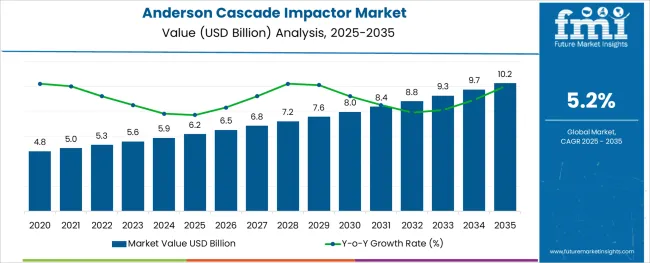
The Anderson Cascade Impactor market is progressing steadily, driven by the need for precise particle size analysis in pharmaceutical and environmental applications. The increasing emphasis on aerosol characterization and inhalation therapy efficacy has raised demand for advanced cascade impactor technologies. Industry insights indicate that regulatory agencies require detailed particle size distribution data to ensure product quality and safety.
Innovations in sample collection methods and mesh disc designs have improved measurement accuracy and operational convenience. The market growth is also supported by the rise in respiratory diseases and the need for efficient drug delivery systems.
Expansion in research and development activities within pharmaceutical companies and environmental monitoring agencies has further boosted demand. Future growth is expected as new standards emerge and the importance of detailed particle analysis continues to grow. Segmental growth is expected to be driven by the Compact Cascade Impactor five-stage unit, use of sticky surfaces to reduce particle bounce, and ground-based sample collection filters.
The market is segmented by Mesh Disc Stage Unit, Particle Bounce, and Sample Collection Filters and region. By Mesh Disc Stage Unit, the market is divided into Compact Cascade Impactor (CCI) five stage and Compact Cascade Impactor (CCI) six stage. In terms of Particle Bounce, the market is classified into Using Sticky Surfaces, Sampling at high humidity, Porous substrate, and Virtual Impactor. Based on Sample Collection Filters, the market is segmented into Ground-based and Airborne. Regionally, the market is classified into North America, Latin America, Western Europe, Eastern Europe, Balkan & Baltic Countries, Russia & Belarus, Central Asia, East Asia, South Asia & Pacific, and the Middle East & Africa.
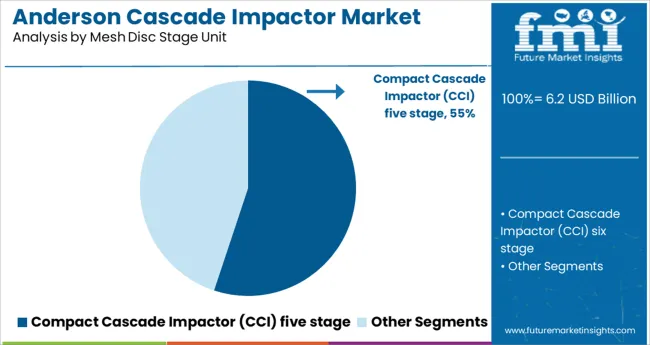
The Compact Cascade Impactor (CCI) five-stage segment is projected to contribute 55.1% of the market revenue in 2025, holding a dominant position among mesh disc stage units. This segment’s growth is attributed to the compact design and multi-stage capability that allows precise separation and analysis of aerosol particles across different size ranges.
Its portability and ease of use have made it popular in laboratory and field settings, enhancing the flexibility of aerosol testing. The ability to capture detailed size distribution profiles is essential for inhalation drug formulation and environmental pollutant studies.
As aerosol characterization requirements become more stringent, the demand for multi-stage impactors such as the CCI five-stage is expected to increase, solidifying this segment’s leading role.
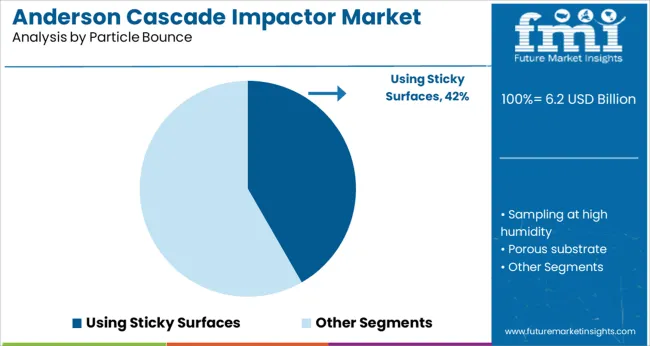
The segment involving the use of sticky surfaces to reduce particle bounce is projected to account for 41.7% of the market revenue in 2025. This approach has been favored as it minimizes particle rebound during sampling, resulting in more accurate particle size measurements.
Sticky surfaces improve collection efficiency and reduce errors caused by particles that would otherwise dislodge and alter distribution data. Research and development efforts have optimized adhesive materials and coating techniques to enhance particle capture without interfering with sample integrity.
As accurate particle characterization remains critical for drug delivery and environmental monitoring, sticky surface technology continues to gain adoption, contributing significantly to market growth.
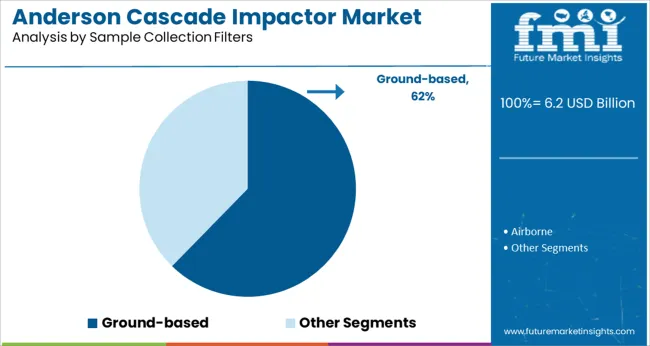
The ground-based sample collection filters segment is expected to hold 62.3% of the market revenue in 2025, maintaining its dominance among collection filter types. Ground-based filters are widely used due to their robustness, reliability, and ease of integration into various testing systems.
They provide stable sample retention and support extended sampling durations necessary for detailed analysis. Their compatibility with multiple impactor configurations and testing protocols makes them versatile tools in both pharmaceutical and environmental applications.
The durability and reusability of ground-based filters also contribute to their preference in laboratories focused on cost efficiency. With ongoing demand for comprehensive particle size and concentration data, this segment is anticipated to sustain its leadership position.
The pharmaceutical industry has a high demand for inhalation product development in order to develop treatments that deliver systematic drugs via the pulmonary route. As asthma and chronic obstructive pulmonary diseases (COPD) become more common, and there is a growing reputation for Anderson cascade impactors, the industry is responding by investing heavily in both formulation and device research in the Anderson cascade impactor market, and this becomes the market's best driving effect.
While Anderson cascade impactor have many advantages over all other methods, they are bulky and not very portable, making them difficult to use in an industrial setting, and the disc membrane provided by TOEM does not provide any size information. Such factors are discouraging industrials from effectively suing Anderson cascade impactor, ultimately harming the cascade impactor market as a whole.
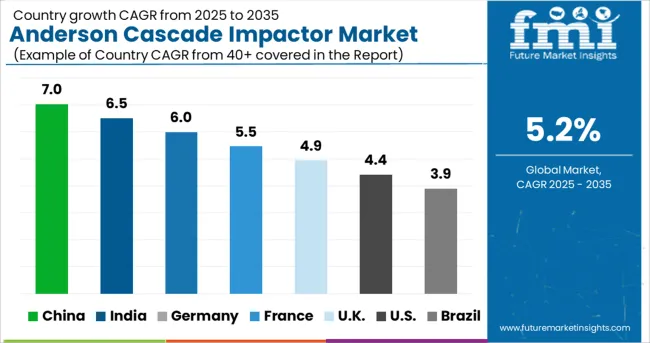
The Anderson cascade impactor market is extensive in European regions such as Switzerland, France, and the United Kingdom, and it is expected to grow by 25% because Europe is known for its innovation and many products in the R&D stages.
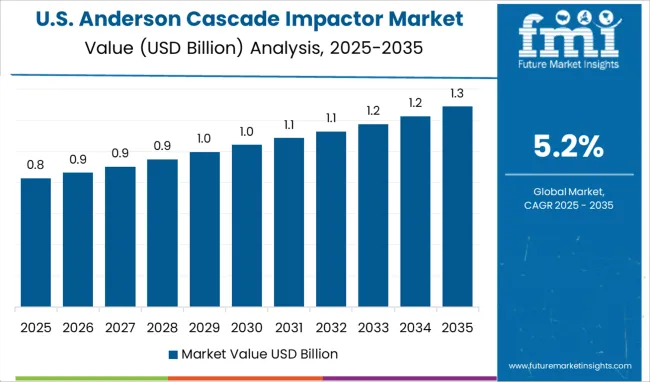
According to Future Market Insights, North America is a major Anderson cascade impactor demand and supply chain influencer due to its influences in the pharmaceutical market, both in consumption and development, with medical spending expected to increase by 5% per year from 2025 to 2035, reaching approximately USD 7 trillion.
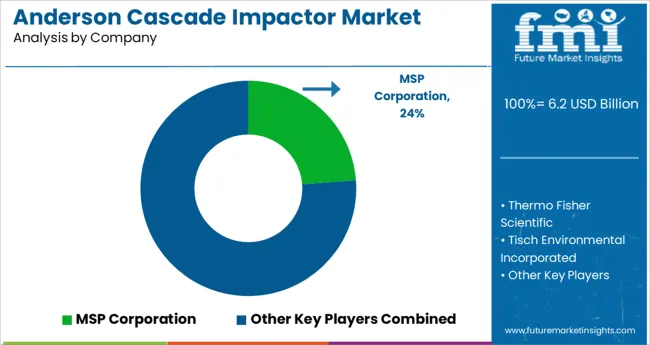
Some of the key participants present in the global Anderson Cascade Impactor market include MSP Corporation, Thermo Fisher Scientific, Tisch Environmental Incorporated, Apex Chromatography Private Limited, BGI Incorporated, Mesa Laboratories Incorporated, SKC Incorporated and Copley Scientific among others.
| Report Attribute | Details |
|---|---|
| Growth Rate | CAGR of 5.2% from 2025 to 2035 |
| Base Year for Estimation | 2024 |
| Historical Data | 2020 to 2024 |
| Forecast Period | 2025 to 2035 |
| Quantitative Units | Revenue in billion, Volume in Kilotons and CAGR from 2025-2035 |
| Report Coverage | Revenue Forecast, Volume Forecast, Company Ranking, Competitive Landscape, Growth Factors, Trends and Pricing Analysis |
| Segments Covered | Mesh Disc Stage Units, Particle Bounce, Sample Collection Filters, Region |
| Regions Covered | North America; Latin America; Western Europe; Eastern Europe; Asia Pacific; Japan; Middle East and Africa |
| Key Countries Profiled | USA, Canada, Brazil, Argentina, Germany, UK, France, Spain, Italy, Nordics, BENELUX, Australia & New Zealand, China, India, ASEAN, GCC, South Africa |
| Key Companies Profiled | MSP Corporation; Thermo Fisher Scientific; Tisch Environmental Incorporated; Apex Chromatography Private Limited; BGI Incorporated; Mesa Laboratories Incorporated; SKC Incorporated; Copley Scientific |
| Customization | Available Upon Request |
The global anderson cascade impactor market is estimated to be valued at USD 6.2 billion in 2025.
It is projected to reach USD 10.2 billion by 2035.
The market is expected to grow at a 5.2% CAGR between 2025 and 2035.
The key product types are compact cascade impactor (cci) five stage and compact cascade impactor (cci) six stage.
using sticky surfaces segment is expected to dominate with a 41.7% industry share in 2025.






Full Research Suite comprises of:
Market outlook & trends analysis
Interviews & case studies
Strategic recommendations
Vendor profiles & capabilities analysis
5-year forecasts
8 regions and 60+ country-level data splits
Market segment data splits
12 months of continuous data updates
DELIVERED AS:
PDF EXCEL ONLINE
Quantum Cascade Laser Market Size and Share Forecast Outlook 2025 to 2035
Quantum Cascade Lasers Market Growth - Trends & Forecast 2025 to 2035

Thank you!
You will receive an email from our Business Development Manager. Please be sure to check your SPAM/JUNK folder too.
Chat With
MaRIA